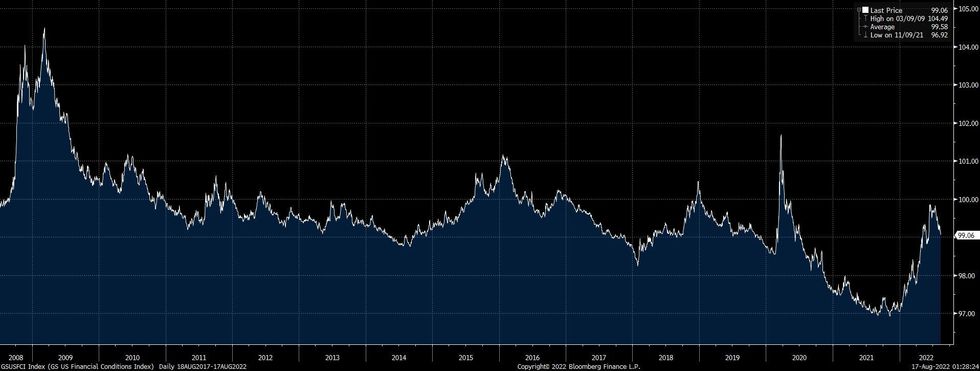US: A Look At Financial Conditions
U.S. financial conditions sit around levels observed in early May & early June, despite the Fed delivering 200bp of tightening since the start of May. An elevation in recession worry, a pullback in market pricing re: the terminal rate of the current Fed hiking cycle (along with the Fed reaching its estimate of the long run estimate of interest rates), speculation surrounding a dovish Fed pivot, along with a related pullback from cycle highs when it comes to mortgage rates and a retracement in equities from YtD cheaps are the main drivers for the moderations from recent tights in financial conditions.
- Financial conditions had been on a fairly one-way tightening trajectory through to their June peak (from the all-time lows lodged last year), with the subsequent pullback likely a key input when it comes to the recent hawkish musings from some of the historically dovish regional Fed Presidents (namely Daly and Kashkari) as the Fed looks to underpin its fight against inflation.
Fig. 1: Goldman Sachs U.S. Financial Conditions Index
 Source: MNI - Market News/Goldman Sachs/Bloomberg
Source: MNI - Market News/Goldman Sachs/Bloomberg
Want to read more?
Find more articles and bullets on these widgets:
Historical bullets
US TSYS: Steady Start
A fairly flat start to the new week for the wider Tsy space, with the closure of cash Tsy trade until London hours (on the back of a Japanese holiday) limiting activity/liquidity. Futures were happy to look through the latest round of NZ CPI data, with participants set for a session of headline watching, at least until London hours. TYU2 is +0-05 at 118-25+, trading at the peak of its 0-07 range, nudging higher in recent dealing. E-minis are back from their early session highs, last dealing 0.1-0.3% firmer, with the NASDAQ 100 contract leading.
KRW: Won Capitalises On Greenback Weakness, FinMin Choo Sees Inflation Peaking In Oct
Spot USD/KRW dropped as onshore markets re-opened, playing catch-up with greenback weakness seen last Friday and extending into this morning. The U.S. dollar went offered towards the end of last week as data showed that long-term inflation expectations of U.S. consumers fell, while latest rounds of Fedspeak were interpreted as decreasing the odds of a 100bp hike at the next FOMC meeting.
- When this is being typed, spot USD/KRW trades -7.15 figs at KRW1,319.05. A pullback under the 50-DMA/Jun 27 low at KRW1,282.76/1,280.65 would suggest that bears are retaking control. Bulls look for a jump above Jul 15 cyclical high of KRW1,326.65 to confirm that the current uptrend remains intact.
- USD/KRW 1-month NDF last seen at KRW1,318.48, marginally lower on the day. Bears keep an eye on the 50-DMA/Jun 28 low at KRW1,281.33/1,279.75. Bulls eye Jul 15 high of KRW1,329.02 for initial resistance.
- "Unless global oil prices soar higher, I expect our inflation to stay elevated until October before it starts to gradually settle down from there," FinMin Choo told Bloomberg. The minister noted that "in the unlikely case" inflation could reach +7.0% Y/Y, but "it would be very brief." He also played down potential for an imminent recession or economic slowdown.
- Looking ahead, South Korea's trade data for the first 20 days of the month will be published on Thursday.
JPY: Goldman: Further Pressures, But Sticking With Constructive Medium-Term View
Goldman Sachs note that “while negative terms of trade developments - i.e., higher natural gas prices and higher oil prices (prior to the latest sell-off) - have weighed on the Yen this year, USD/JPY has mostly been trading in line with real rate differentials YTD. We expect this fairly tight relationship to persist due to the BoJ’s commitment to YCC and thus see few headwinds to further Yen depreciation in the very near term. Specifically, our economists expect no changes to YCC at next week’s meeting (nor through at least the rest of Kuroda's term, as of now), while markets expect the Fed to hike by another 75bp at the July meeting. That said, we continue to see a strong case for JPY appreciation over the medium-term, resulting from either (i) a significant U.S. economic slowdown/recession or (ii) a change in Japanese monetary policy. A scenario in which Japanese inflation remains uniquely low even as the economy reopens, allowing the BoJ to remain on hold while other central banks hike, has seemed like a low probability outcome, in our view. This was reinforced by our economists’ latest upward revisions to their inflation forecasts, now showing new core CPI at 2% by year-end. Overall, we would expect to see further upside pressure on USD/JPY in the next few weeks, barring any significant sell-off in oil prices or a (very unlikely) dovish shift in Fed expectations.”